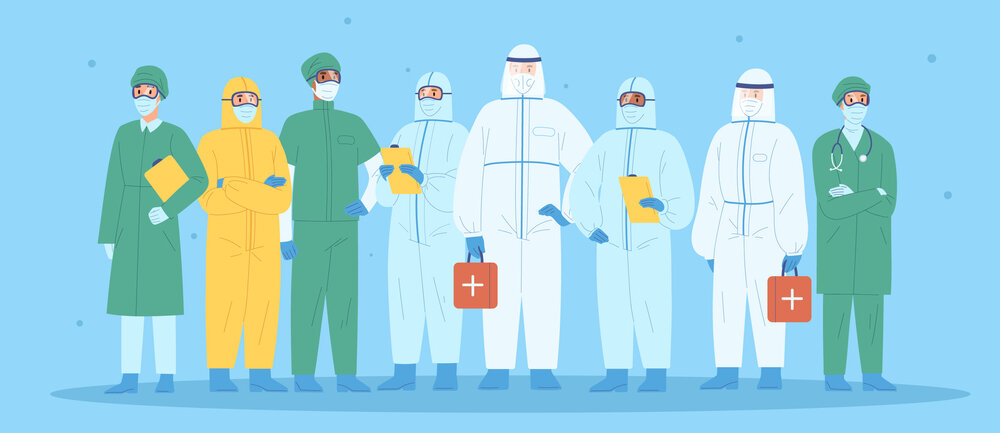Gowns are standard personal protective equipment (PPE) used in the healthcare industry and are like a superhero costume for healthcare professionals. Each piece plays a crucial role in safeguarding the medical staff and patients.
So, let’s talk about PPE gowns first. They act as a shield, preventing contact with infectious agents or contaminants. It’s like a strong force field against germs.
Now, protective hoods are like the capes of the superhero costume. They cover the head and neck, providing an extra layer of defense. Think of them as the first line of defense against potential airborne threats.
And remember boots. They’re like the sturdy boots of a superhero, protecting against spills and splashes. A simple yet essential part of the ensemble, ensuring that no nasty surprises make their way into the sacred space of a medical professional.
In the world of healthcare, these elements combine to create a powerful armor, defending against invisible foes and keeping the medical team in the best shape to save the day. It’s a classic case of dressing for success in a germ-free, safe medical environment.
Let’s discover more details about medical gowns with us!
Types of Medical Gowns:
To keep their staff members secure and at low risk of infections while working, hospitals and other healthcare facilities are responsible for supplying high-quality PPE. Protective apparel for doctors and other medical professionals comes in a variety of styles. Here are a few of the PPE gowns that are most frequently used.
Surgical Gowns:
Surgical gowns must get a 501(k) premarket notification since they are classified as Class II medical equipment. These protective medical gowns must meet a very high standard of quality because they are subject to FDA regulation in the United States. Any medical professional performing surgery should wear one of these to protect both themselves and the patient from the spread of pathogenic bacteria, bodily fluids, and other potentially dangerous items.
To maximize safety and sanitation levels in a surgical setting, important zones of protection must be identified. The front of the body has critical zones that extend from the shoulders to the knees and from the wrists to just above the elbow. These robes can be used at danger levels ranging from 1 to 4. For clarification, in urgent medical situations, they are specifically labeled as “surgical gowns.”
Non-surgical Gowns:
Non-surgical gowns should not be used in places where there is a medium to high risk of contamination or during invasive procedures like surgery. They fall under the Class I medical device category and are exempt from premarket approval. Their main function is to shield the wearer from the transmission of fluids or microbes in low- to moderate-risk medical settings, such as a standard physical examination.
These gowns may resemble ones intended for surgery in appearance. They must perform at the highest levels of liquid barrier performance in their classification in order to protect the vital zones.
All other parts of the gown, except the bindings, cuffs, and hems, are crucial protection zones. The gown’s liquid barrier protection should extend to the seams as well.
Isolation Gowns:
Although they can be worn during invasive medical procedures, surgical isolation gowns are only intended for medium- to high-risk settings. In situations where the likelihood of contamination is higher, a bigger critical zone of protection is required. All medical situations can be handled with standard surgical gowns. Similar to surgical gowns, these garments require a 501(k) premarket notice.
Isolation gowns are both reusable and disposable in hospitals. However, disposable gowns make up 80% of the hospital supplies. Single-use gowns are typically produced utilizing synthetic fibers like polyester, polypropylene, and polyethylene as raw materials. Each time they are worn, reusable gowns need to be washed. Isolation gowns with several uses can be produced from either 100% cotton, 100% polyester, or a combination of the two.
Gown Levels:
A patient or medical professional needs a certain kind of gown, depending on their work environment and exposure level. Various gown styles are available, including surgical and patient gowns. All high-quality medical gowns are graded into levels 1 through 4 by the FDA.
Level 1
This kind of gown is used in low-risk medical circumstances like simple care and patient visits, as well as isolation. You may wear them for extended periods of time because they are comfortable, lightweight, and breathable.
Level 2
These gowns are made for low-risk situations, including collecting blood, suturing, and working in a pathology lab or intensive care unit (ICU). Through fluid resistance, they provide more security than level 1 gowns. The gown is put through two tests to make sure it stops soaking and penetration.
Level 3
These medical gowns are designed for situations with a moderate level of danger, such as inserting an intravenous (IV) line or taking arterial blood. These medical robes include reinforced fabric, some of them for further security.
Level 4
Level 4 medical gowns have the best available protection, making them ideal for risky circumstances like surgery or fluid-intense operations. They are the most bacterial illness and spread resistance.
Conclusion:
Safeguarding your well-being starts with being well-informed about medical gowns, and for superior protective hoods and boots, the best provider stands as your reliable ally. Their unwavering commitment to delivering top-quality products positions them as the ultimate destination for all your protective gear requirements. Don’t hesitate; to take the proactive step towards ensuring your safety by reaching out to them today. Your peace of mind deserves nothing less than the best protective equipment.














